| Listing 1 - 10 of 45 | << page >> |
Sort by
|
Book

Year: 2014 Publisher: Gaithersburg, MD : U.S. Dept. of Commerce, National Institute of Standards and Technology,
Abstract | Keywords | Export | Availability | Bookmark
 Loading...
Loading...Choose an application
- Reference Manager
- EndNote
- RefWorks (Direct export to RefWorks)
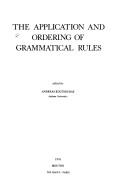
ISBN: 9027934843 9789027934840 Year: 1976 Volume: 100 Publisher: The Hague Mouton
Abstract | Keywords | Export | Availability | Bookmark
 Loading...
Loading...Choose an application
- Reference Manager
- EndNote
- RefWorks (Direct export to RefWorks)
Grammar --- Order (Grammar) --- Congresses --- -Linear ordering (Grammar) --- Ordering constraints (Grammar) --- Grammar, Comparative and general --- Sequence (Linguistics) --- Congresses. --- -Congresses --- Linear ordering (Grammar) --- Order (Grammar) - Congresses
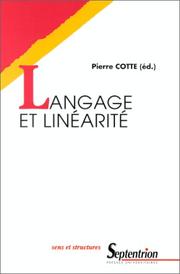
ISBN: 2859395830 2757434608 9782859395834 Year: 1999 Publisher: Villeneuve d'Ascq Presses universitaires du Septentrion
Abstract | Keywords | Export | Availability | Bookmark
 Loading...
Loading...Choose an application
- Reference Manager
- EndNote
- RefWorks (Direct export to RefWorks)
Le langage est linéaire, mais cela importe t-il ? L’ouvrage consacré à la question, étudie la mise en forme du sens dans l’énonciation, la relation entre le sens et les positions syntaxiques, la (dé)linéarisation des messages.
Lexicology. Semantics --- Stilistics --- Literature --- Order (Grammar) --- Order (Grammar). --- Linear ordering (Grammar) --- Ordering constraints (Grammar) --- Grammar, Comparative and general --- Sequence (Linguistics) --- langage --- langue française --- linéarité
Multi
ISBN: 9780521872140 9780521693127 0521693128 0521872146 9781139033930 9781139376716 1139376713 9781139379571 1139379577 1139365614 110722585X 1280663898 9786613640826 1139378147 1139375288 113903393X 1139371290 Year: 2012 Publisher: Cambridge Cambridge University Press
Abstract | Keywords | Export | Availability | Bookmark
 Loading...
Loading...Choose an application
- Reference Manager
- EndNote
- RefWorks (Direct export to RefWorks)
Word order is one of the major properties on which languages are compared and its study is fundamental to linguistics. This comprehensive survey provides an up-to-date, critical overview of this widely debated topic, exploring and evaluating word order research carried out in four major theoretical frameworks - linguistic typology, generative grammar, optimality theory and processing-based theories. It is the first book to bring these theoretical approaches together in one place and is therefore a one-stop resource covering the current developments in word order research. It explains word order patterns in different languages and at different structural levels and critically evaluates (and where possible, compares) the theoretical assumptions and word order principles used in the different approaches. Also highlighted are issues and problems that require further investigation or remain unresolved. This book will be invaluable to those investigating word order, and researchers and students in syntax, linguistic theory and typology.
Grammar --- Grammar, Comparative and general --- Grammaire comparée --- Word order --- Ordre des mots --- Word order. --- Grammaire comparée --- Language and languages --- Order (Grammar) --- Linear ordering (Grammar) --- Ordering constraints (Grammar) --- Sequence (Linguistics) --- Arts and Humanities --- Language & Linguistics --- Linguistics --- Philology --- Syntaxe
Book
ISBN: 2902731841 9782902731848 Year: 1984 Publisher: Les Ulis : Editions de physique,
Abstract | Keywords | Export | Availability | Bookmark
 Loading...
Loading...Choose an application
- Reference Manager
- EndNote
- RefWorks (Direct export to RefWorks)
Order-disorder in alloys --- Congresses --- -Ordering in alloys --- Alloys --- Domain structure --- Order-disorder models --- Phase rule and equilibrium --- Physical metallurgy --- -Congresses --- Ordering in alloys --- Order-disorder in alloys - Congresses --- Solid state physics

ISBN: 9027227381 1556199015 128323422X 902728234X 9786613234223 Year: 1997 Publisher: Amsterdam ; Philadelphia : John Benjamins Pub. Co.,
Abstract | Keywords | Export | Availability | Bookmark
 Loading...
Loading...Choose an application
- Reference Manager
- EndNote
- RefWorks (Direct export to RefWorks)
Symmetries and asymmetries have always played an important role in linguistic theorizing. From the early works on potentially universal properties of transformational processes, differences between rightward and leftward movement processes were noted and constituted a challenge to theories of conditions on transformations. The upward boundedness of extraposition rules vs. the successive cyclic character of question word movement, for example, remains a vexing problem. An idea which has gained considerable prominence in the most recent syntactic work, in particular Noam Chomsky's 'Minimalist Pr
Order (Grammar) --- Generative grammar --- Ordre (Grammaire) --- Grammaire générative --- Generative grammar. --- Grammar, Comparative and general --- Grammar, Generative --- Grammar, Transformational --- Grammar, Transformational generative --- Transformational generative grammar --- Transformational grammar --- Psycholinguistics --- Linear ordering (Grammar) --- Ordering constraints (Grammar) --- Sequence (Linguistics) --- Derivation
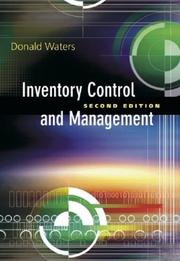
ISBN: 0470858761 Year: 2004 Publisher: Chichester Wiley
Abstract | Keywords | Export | Availability | Bookmark
 Loading...
Loading...Choose an application
- Reference Manager
- EndNote
- RefWorks (Direct export to RefWorks)
658.74 --- 658.51 --- 658.51 Organization of production --- Organization of production --- 658.74 Ordering --- Ordering --- Inventory control --- Control, Inventory --- Inventory management --- Stock control --- Business logistics --- Physical distribution of goods --- Production control --- Inventories --- Inventory control.
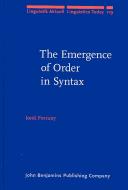
ISBN: 9789027255020 9027255024 9786612152207 1282152203 9027291543 9789027291547 9781282152205 Year: 2008 Volume: 119 119 Publisher: Amsterdam Philadelphia John Benjamins Pub.
Abstract | Keywords | Export | Availability | Bookmark
 Loading...
Loading...Choose an application
- Reference Manager
- EndNote
- RefWorks (Direct export to RefWorks)
The syntactic component of the faculty of language is argued to be a rewiring of a few independently motivated components: features, the conjunction of a successive operation of union-formation ('Merge') and of derivational records ('nests'), and principles of analysis. Since nests linearize terminals (Kuratowski 1921), Kayne's (1994) LCA becomes dispensable. The study of how features are ordered in discontinuous, analytic and syncretic patterns, governed by the Full Interpretation Condition and the Maximize Matching Effects Principle, provides a simple account for several syntactic phenomena, like the C-Infl connection, certain cartographic observations due to Cinque (1999), the A'-status of preverbal subjects in Null Subject Languages (Solà 1992), the alleviation of wh-island effects in English when the embedded wh-phrase is a subject (Chomsky 1986) and the dynamic V2 patterns in double agreement dialects observed by Zwart (1993). The possibility that Comp-trace effects derive from the contraction of the C-Infl discontinuity is explored and subject islands and wh-islands are derived from the Relativized Opacity Principle, an alternative to Chomsky's PIC.
Grammar, Comparative and general --- Order (Grammar) --- Syntax --- 801.56 --- Language and languages --- 801.56 Syntaxis. Semantiek --- Syntaxis. Semantiek --- Linear ordering (Grammar) --- Ordering constraints (Grammar) --- Sequence (Linguistics) --- Syntax. --- Linguistics --- Philology --- Grammar, Comparative and general - Syntax --- Grammar, Comparative and general Syntax
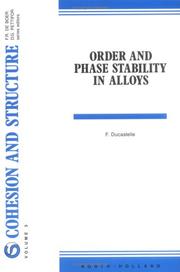
ISBN: 0444869735 Year: 1991 Volume: 3 Publisher: Amsterdam North-Holland
Abstract | Keywords | Export | Availability | Bookmark
 Loading...
Loading...Choose an application
- Reference Manager
- EndNote
- RefWorks (Direct export to RefWorks)
Order-disorder in alloys --- Ordering in alloys --- Alloys --- Domain structure --- Order-disorder models --- Phase rule and equilibrium --- Physical metallurgy
Book
ISBN: 904853741X Year: 2020 Publisher: Baltimore, Maryland : Project Muse,
Abstract | Keywords | Export | Availability | Bookmark
 Loading...
Loading...Choose an application
- Reference Manager
- EndNote
- RefWorks (Direct export to RefWorks)
Software has become a key component of contemporary life and algorithmic techniques that rank, classify, or recommend anything that fits into digital form are everywhere. This book approaches the field of information ordering conceptually as well as historically. Building on the philosophy of Gilbert Simondon and the cultural techniques tradition, it first examines the constructive and cumulative character of software and shows how software-making constantly draws on large reservoirs of existing knowledge and techniques. It then reconstructs the historical trajectories of a series of algorithmic techniques that have indeed become the building blocks for contemporary practices of ordering. Developed in opposition to centuries of library tradition, coordinate indexing, text processing, machine learning, and network algorithms instantiate dynamic, perspectivist, and interested forms of arranging information, ideas, or people. Embedded in technical infrastructures and economic logics, these techniques have become engines of order that transform the spaces they act upon.
Computer software. --- Algorithms. --- Algorism --- Algebra --- Arithmetic --- Software, Computer --- Computer systems --- Foundations --- algorithms, information ordering, media archaeology, software studies.
| Listing 1 - 10 of 45 | << page >> |
Sort by
|

 Search
Search Feedback
Feedback About UniCat
About UniCat  Help
Help News
News